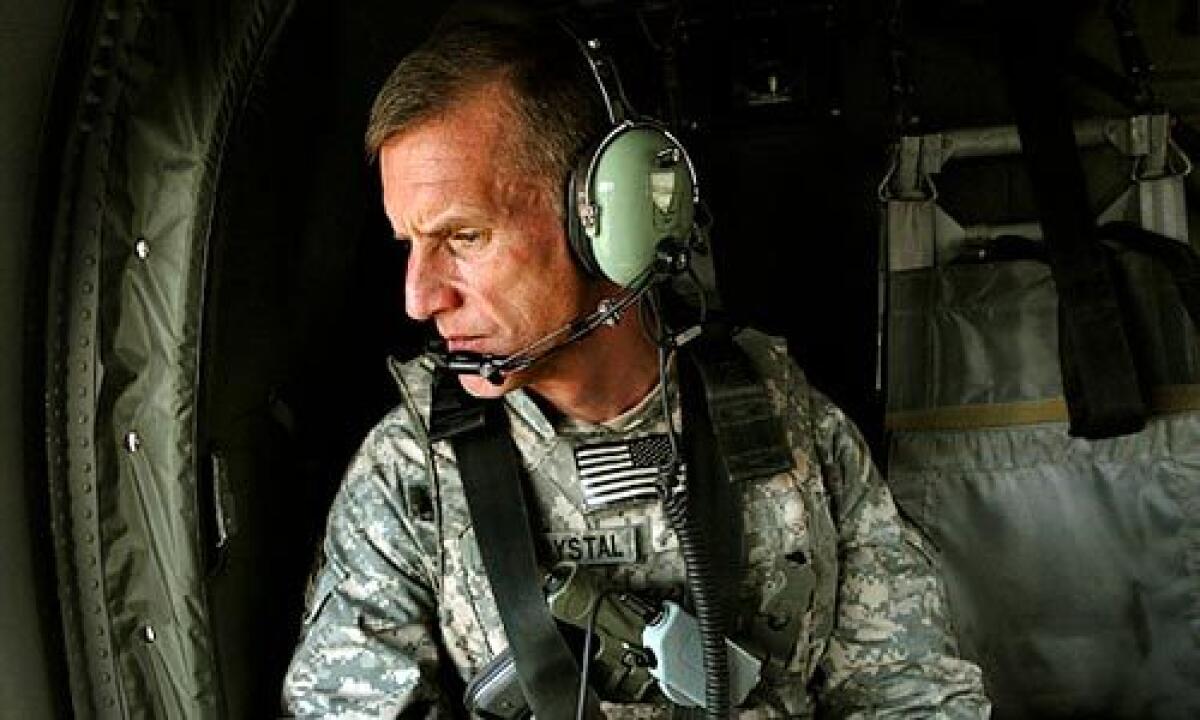Afghanistan ride-a-long with Gen. Stanley McChrystal

As Army Gen. Stanley A. McChrystal’s helicopter flies over the steep mountains and deep valleys of Afghanistan, he gazes at a remote village below. Mud huts cling to the side of the peaks like barnacles. They are barely accessible by road.
“I am sure many of the people living in that village have never left,” McChrystal says. “It must be a harsh life, but also simple.”
He pauses, and adds, “There’s something to be said for simplicity.”
There’s nothing simple about McChrystal’s life.
As the top U.S. commander in Afghanistan, he spends several days a week visiting base camps across the country and meeting with local officials, some of whom have plenty of grievances. One day last week, McChrystal arrived before lunch at Camp Kunduz, not far from the border with Tajikistan. The first order of business is a show-and-tell by the German troops there, who displayed their high-tech equipment, including armored personnel carriers, a mobile rocket launcher and surveillance drones.
“Do they make a lot of noise? How do you get them back?” McChrystal asks one of the German soldiers. (More than 3,500 German troops serving in a NATO-led force are deployed in northern Afghanistan and Kabul.)
After reviewing the lineup of military might, McChrystal heads to the base for a briefing, which he has requested not include a PowerPoint presentation. The session lasts more than an hour, which is short in comparison to his next Q-and-A with community leaders from Kunduz province.
To get safely into town, McChrystal is transported in a German convoy of 11 Humvees sandwiched between two armored personnel carriers from which soldiers keep watch through submarine-style scopes. The convoy looks more like a military parade (without the waving flags) than a public relations mission. But security is an issue; the number of insurgent attacks is on the rise.
Kunduz Gov. Mohammad Omar, an engineer by training, greets the general with traditional Afghan hospitality. A dozen representatives of various armed forces, including leaders of the Afghan, German and American military and Afghan police, are gathered, all with notepads in hand. Some of the chairs still have their plastic wrapping and USAID stickers.
The governor wastes no time in stating his needs.
“We need four helicopters here, so that we can react more quickly to the enemy,” he says. “We have a very big river which divides the province and we are not able to maintain control on both sides. The river in this province is a big obstacle at certain times of the year.”
He says he needs more police but that police are allocated by the number of districts, not population, and his province has only six districts.
“For a long time,” Omar says, “I have requested that the number of districts . . . . be increased.”
“In the beginning of the interim government, it was very peaceful here, but now we have security problems,” he says. “The people here cannot send their girls to school.
“As long as we have this open border with Pakistan, this problem is going to exist for a long time. I guarantee you, if we don’t do something about the situation here, we will be as busy here [in Kunduz] as we are in Helmand.”
McChrystal asks about the local Taliban. The governor responds: “The Taliban leaders here are from Helmand and the rest are from Pakistan. . . . Their families don’t live here, so we don’t have any way to control them.” “That’s why I am here,” McChrystal says. “I spoke to President Karzai recently and I am very worried about Kunduz,” he says. “I think we need to look at how we operate. I think there are better ways. What we need to do is understand the problem and look at the resources. We -- the coalition -- need to change the way we partner with the Afghan forces so that we partner more closely as we go forward.
“I agree on the weapons and barracks, but that is a part of the bigger process. I can’t promise anything.
“But I am going to ask that we grow the Afghan forces faster than we are now.”
As the two-hour meeting ends, Omar presents McChrystal with a traditional coat, which he briefly puts on.
The convoy pulls out in the direction of the marketplace, where the plan is to stop to greet locals. Instead, the convoy goes in circles, as Afghan police stop traffic and people stare warily. It’s unclear why the bazaar visit is canceled, but security is mentioned as a concern. German convoys have been attacked several times in recent months.
On the hourlong ride back to Kabul, the general types notes on his laptop, occasionally glancing outside. At a few thousand feet, Afghanistan appears picturesque and peaceful. The temperature drops as the chopper crosses the highest peaks, where snow and ice remain year-round.
Next, the aircraft drops into the Shomali plain, north of Kabul, the site of fierce American bombing in late 2001.
The fields are now green and groomed. “It looks good down there,” McChrystal says.
The copter finally descends into Kabul, where houses rise on the surrounding hills.
“I used to deliver newspapers as a boy, and those hills would have been a tough route,” he says, reminiscing. “ . . . That was a good job.”
More to Read
Start your day right
Sign up for Essential California for news, features and recommendations from the L.A. Times and beyond in your inbox six days a week.
You may occasionally receive promotional content from the Los Angeles Times.







